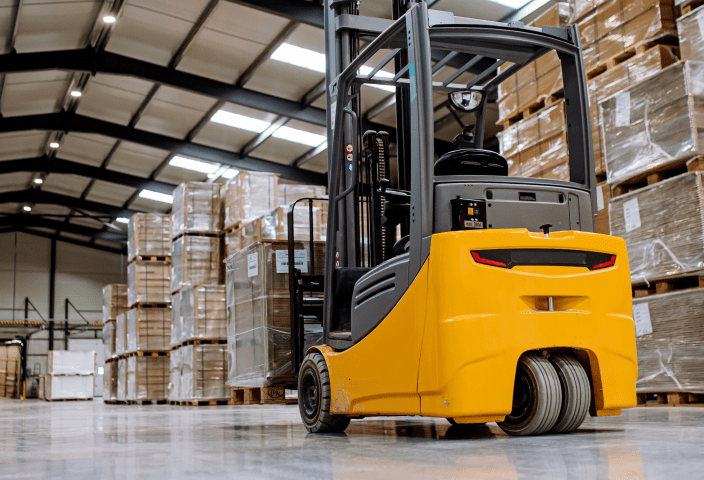Read our SAP Extended Warehouse Management (SAP EWM) guide and learn how it can help your organization improve day-to-day warehousing while reducing costs.
What happens when production lines keep moving, but the warehouse behind them doesn’t? Materials arrive late. Assembly stops. Orders fall behind. And why? Usually, it's poor coordination between production and warehouse operations. Manual tracking, unclear task priorities, and missing stock updates all add up — and incur significant costs.
SAP Extended Warehouse Management (SAP EWM) changes that. It brings structure to the warehouse side of production and cuts the delays and errors that slow everything down. Want to know how it works and where it makes the biggest difference? Keep reading.
The Evolution of Production Warehousing
Production warehouses didn’t always need complex systems. For years, spreadsheets, basic WMS tools, and manual routines were enough. But the shift to just-in-time manufacturing, higher customization, and shorter lead times changed the game. Warehouses are now expected to move faster, make fewer errors, and stay in sync with production — all at once.
Some problems are new, while others have existed for decades. But because of their scale and speed, they now create bigger risks. A slight delay or a wrong pick can halt production lines that run 24/7.
Even with all the changes, one thing stays the same: the warehouse continues to be a part of the production process. But now, its role is more active, connected, and time-sensitive than ever. To keep up, many manufacturers have started turning to more advanced systems that can handle this growing complexity.
SAP EWM is one of those solutions — and like production warehousing itself, it didn’t appear overnight.
How SAP EWM Became What It Is Today
SAP Extended Warehouse Management (SAP EWM) is a software system designed to manage complex warehouse operations and logistics processes. It goes far beyond simple inventory tracking — it helps coordinate goods movements, manage labor tasks, and connect warehouse workflows with production activities.
Before SAP EWM, companies used SAP Warehouse Management (SAP WM), a tool introduced in the 1990s. SAP WM was built to support basic warehouse functions: storage, picking, putaway, and stock management. It worked well for many years, especially in simpler warehouse setups.
However, as supply chains grew more global and production became more time-critical, SAP WM started showing its limits. It lacked the flexibility and depth needed to support larger, faster, and more dynamic operations.
In response, SAP released SAP EWM in 2005. This was not just an upgraded version of WM, but a new system for businesses that needed more detailed control over their warehouses. EWM offered better support for high-volume environments, more advanced task management, and closer integration with production and transportation planning.
Today, SAP EWM continues to evolve. It supports decentralized and embedded deployment options within SAP S/4HANA. EWM is considered the go-to warehouse management solution in the SAP ecosystem for complex scenarios, including those found in production environments.
Ready for SAP EWM? Let us help you find the right path to improve your warehouse operations.
SAP EWM vs. Microsoft Dynamics 365 SCM — Choosing the Right Tool for the Job
SAP EWM and SAP WM: What are their Main Differences?
As warehousing operations scale and mostly move to S/4HANA, the capabilities of SAP WM are no longer capable of meeting modern demands, making the advanced features of SAP EWM a strategic necessity.
Let’s define the difference between the two systems. SAP WM processes basic warehouse requests within the older SAP ECC system. Meanwhile, SAP EWM was designed for the modern SAP S/4HANA landscape, providing advanced solutions for such labor-intensive operations as inventory control, yard management, and resource planning.
Additionally, EWM integrates with other supply chain modules, including Quality Management (QM) and Transportation Management (TM), to enhance organizations’ logistics management capabilities at scale.
Mainstream support of SAP ECC and its compatible modules, including SAP WM, will end in December 2025 (for those who purchased extended support, it will end in December 2027). Therefore, the move to SAP EWM is crucial. Consider a more detailed WM and EWM feature comparison in our dedicated article.
How SAP EWM Transforms Production Warehouses
Having defined the main differences between SAP EWM and SAP WM, let’s see what specific processes EWM improves within a production warehouse. After all, it’s not just about storage; rather, the solution ensures consistent synchronization between the warehouse and the factory floors.
Direct integration with manufacturing
EWM connects directly with production planning and execution modules (SAP PP/PP-PI). Using documents such as the Production Material Request (PMR), it analyzes what components are required, where, and when. Next, it creates a single, end-to-end workflow — from order creation to material delivery.
Just-in-time component processing
EWM automates the routing of raw materials and components from the main storage to the PSA
(Production Supply Area) — beside the assembly line. By supporting different staging methods (e.g., create parts, release parts), it ensures materials are supplied at the right time — right when they are needed — preventing downtime due to component shortages.
Automated consumption posting
When production reports that a product is finished, EWM can automatically record components’ consumption from inventory. In this way, EWM provides real-time updates that exclude manual input, reduce errors, and ensure accurate and consistent record-keeping.
Efficient handling of finished goods
Automation doesn’t stop at the consumption stage; EWM streamlines the receipt of finished goods by autonomously generating putaway tasks, recommending workers to the optimal storage bin. It also sets tasks for quality inspections, ensuring ready products are immediately available for shipment to the end customers.
Intelligent inventory and task management
In contrast to basic warehousing systems, SAP EWM allows tracking inventory at the storage bin level — in real time. This capability is crucial for those who work with raw materials, as it allows maintaining accurate stock counting without affecting production deadlines. That is, the system automatically generates and prioritizes tasks (like replenishing the production line) based on the actual demand, rules, and resources available.
Labor and resource optimization
EWM tracks KPIs for production-related warehouse tasks, helping managers optimize workforce allocation, identify bottlenecks in material flows, and plan shifts accordingly — to match production schedules and deadlines.
Yard and dock management
To keep the production process running, managers need to be sure the raw materials enter the facility without delays. With EWM’s Yard Management feature, they can efficiently coordinate the arrival and unloading of trucks; the system assigns materials to the right docks, ensuring their smooth, timely flows to the warehouse and the production line.
Analytics for production logistics
Using EWM’s granular reports covering the entire production flow, managers can estimate completion times for each task, track goods’ movement to and from the production line, and promptly identify bottlenecks (if any) in the process. This data helps to improve the efficiency of the interaction between the warehouse and production facilities.
Benefits of Implementing EWM in Production Warehouses: LeverX’s Experience
Implementing SAP EWM in a production warehouse increases process efficiency and, ultimately, the bottom line. The best way to prove the benefits is to support them with real-world examples. Let’s explore LeverX’s cases, showing how EWM unlocked new and previously untapped potential opportunities for organizations.
Transparency, time-efficiency, and full compliance
Following GMP/FDA standards, we helped a global pharmaceuticals producer improve their raw materials’ traceability across manufacturing units. In the past, their manual processes led to production delays and posed compliance risks.
By implementing SAP EWM, we fully automated their intra-warehouse flows, replenishment, and material handling with barcode-based processing.
The results included:
- A 35% increase in staff productivity.
- A 15% faster creation of material transfer requests.
- 40% fewer material movements at the warehouse.
- 100% compliance with GMP and FDA requirements.
Real-time visibility and supply chain flexibility
Manual planning and disconnected systems often lead to component shortages that halt production.
A large automotive parts manufacturer struggled with warehouse inefficiencies (manual procedures and scattered systems) that halted production and contacted LeverX with this challenge.
As a key part of this digital transformation project, LeverX implemented SAP EWM to introduce real-time task execution through an address-based storage system, RF-based transactions, container tracking, warehouse balance control, and smarter container processing.
The outcomes were:
- A 10% reduction in profit losses due to component shortages.
- A 3% drop in warehouse inventory days improved cash flow.
- Better warehouse visibility and smoother operations.
Challenges of EWM Implementation
While the benefits are compelling, like any major system implementation, SAP EWM requires thorough preliminary planning to foresee potential challenges and prevent them, if possible. To successfully move your current warehouse environment to EWM, you need more than just software installation; you need to conduct a comprehensive project that encompasses technology, processes, and the people involved in it.
Key challenges include:
- Technical integration complexity: Upon integration, ensuring seamless data exchange between EWM and your existing enterprise platforms like ERP, MES, and/or WCS requires deep technical expertise.
- Re-engineering and personnel training: New system implementation often involves re-engineering established workflows and, almost inevitably, personnel resistance, as they get used to legacy procedures.
- Non-customized environments: An ordinary production warehouse has unique inventory management and operational requirements — ones that EWM’s basic configurations may not cover.
- TCO (total cost of ownership): SAP EWM is a comprehensive system that requires significant investments into its support, licensing, and enhancement (upon scaling, as well).
An experienced implementation partner has proven strategies to address these challenges. At LeverX, we solve integration complexities, facilitate user adoption through onsite workshops and training, and tailor the EWM system to meet your needs to maximize ROI.
How to Get Started With SAP EWM
Your path to SAP EWM depends on your current IT landscape and business scenario. However, one thing stays the same in all cases: it all starts with establishing the right SAP S/4HANA environment, whether it’s a migration from a legacy system like SAP WM or a digital transformation of manual workflows.
Based on your business needs, you choose between on-premise, cloud, or hybrid deployment models. Once the foundation is set, you can implement EWM with either basic or advanced features, depending on your operational complexity and goals.
Conclusion: Key Success Factors for the Transformation of Production Warehouses with SAP EWM
As you can see, SAP EWM is a powerful tool encompassing various warehouse management features. Production warehouses choose EWM for process automation, cost optimization through minimized labor efforts, and improved operational control.
Besides technical setup, a successful EWM implementation depends on the following key factors:
- Business goals you want to achieve with the implementation
- Careful planning of all project stages, from design to rollout
- Active personnel engagement in the adoption process
- Qualified EWM implementation experts
- Continuous system adjustment to changing business and market requirements
As trends like AI, robotics, and IoT continue to shape the industry landscape, the role of SAP EWM will grow. The system will offer new opportunities for integration with innovative technologies, and companies that harness these opportunities will always have a competitive edge in the dynamic market.
How LeverX Can Help
Do you need support implementing SAP warehouse management from scratch? Do you want to migrate from SAP WM to EWM? Or maybe you're already using SAP EWM and want to improve its performance? You’re in the right place.
At LeverX, we’ve helped hundreds of businesses across industries build, migrate, and fine-tune their operations with SAP. With over 950 completed projects behind us, our team brings real-world experience — not just templates.
We help with:
- End-to-end SAP EWM implementation
- Migration from SAP WM to EWM, including data and process transfer
- Optimization and customization of current SAP EWM setups
- Integrating EWM with other SAP modules like TM, PP, or MM
- Adapting cloud, hybrid, or on-premise deployment models
- And other SAP-related requests
How useful was this article?
Thanks for your feedback!



